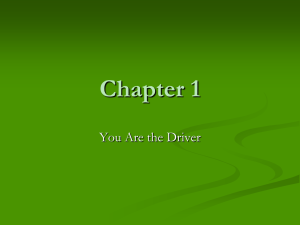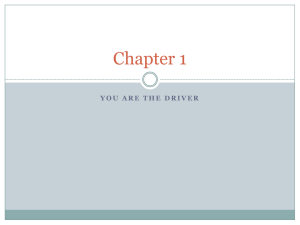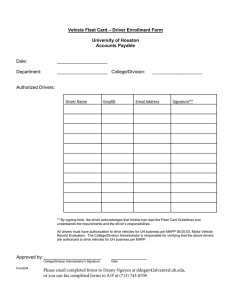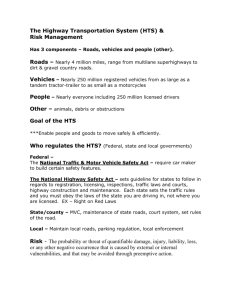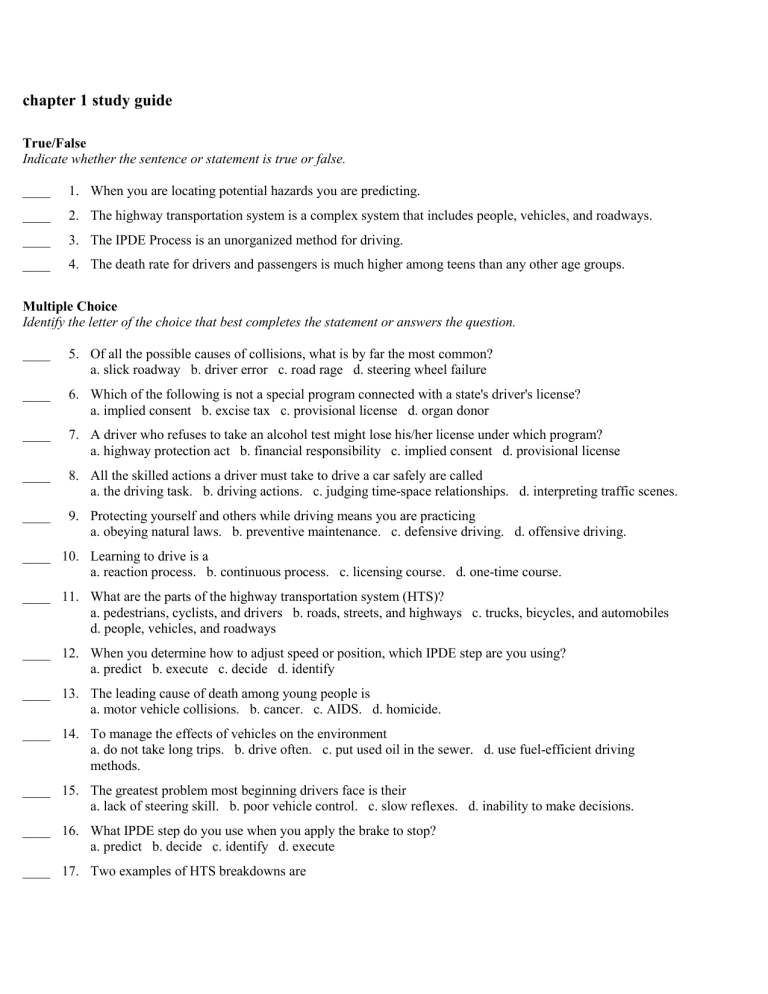
chapter 1 study guide True/False Indicate whether the sentence or statement is true or false. ____ 1. When you are locating potential hazards you are predicting. ____ 2. The highway transportation system is a complex system that includes people, vehicles, and roadways. ____ 3. The IPDE Process is an unorganized method for driving. ____ 4. The death rate for drivers and passengers is much higher among teens than any other age groups. Multiple Choice Identify the letter of the choice that best completes the statement or answers the question. ____ 5. Of all the possible causes of collisions, what is by far the most common? a. slick roadway b. driver error c. road rage d. steering wheel failure ____ 6. Which of the following is not a special program connected with a state's driver's license? a. implied consent b. excise tax c. provisional license d. organ donor ____ 7. A driver who refuses to take an alcohol test might lose his/her license under which program? a. highway protection act b. financial responsibility c. implied consent d. provisional license ____ 8. All the skilled actions a driver must take to drive a car safely are called a. the driving task. b. driving actions. c. judging time-space relationships. d. interpreting traffic scenes. ____ 9. Protecting yourself and others while driving means you are practicing a. obeying natural laws. b. preventive maintenance. c. defensive driving. d. offensive driving. ____ 10. Learning to drive is a a. reaction process. b. continuous process. c. licensing course. d. one-time course. ____ 11. What are the parts of the highway transportation system (HTS)? a. pedestrians, cyclists, and drivers b. roads, streets, and highways c. trucks, bicycles, and automobiles d. people, vehicles, and roadways ____ 12. When you determine how to adjust speed or position, which IPDE step are you using? a. predict b. execute c. decide d. identify ____ 13. The leading cause of death among young people is a. motor vehicle collisions. b. cancer. c. AIDS. d. homicide. ____ 14. To manage the effects of vehicles on the environment a. do not take long trips. b. drive often. c. put used oil in the sewer. d. use fuel-efficient driving methods. ____ 15. The greatest problem most beginning drivers face is their a. lack of steering skill. b. poor vehicle control. c. slow reflexes. d. inability to make decisions. ____ 16. What IPDE step do you use when you apply the brake to stop? a. predict b. decide c. identify d. execute ____ 17. Two examples of HTS breakdowns are a. steering wheel and brake failures. b. running out of fuel and leaving your lights on. c. traffic tie-ups and collisions. d. injury and death. ____ 18. A collision occurs at night between a car with a dirty windshield and one driven by an upset driver. This example illustrates that a. collisions happen to the other person. b. most collisions have a number of causes. c. accidents just happen. d. poor drivers cause most collisions. ____ 19. A state's driving-related laws are found in its a. criminal law book. b. highway map. c. history book. d. vehicle code. ____ 20. When a driver foresees where points of conflict can develop in a driving situation, which step of the IPDE Process is used? a. predict b. execute c. decide d. identify ____ 21. Traffic tie-ups and collisions are examples of a. vehicle codes. b. driving-related expenses. c. defensive driving. d. breakdowns in the HTS. ____ 22. The federal government has established safety guidelines with the a. National Highway Transportation Act. b. National Highway Safety Act. c. Graduated Driver Licensing Program. d. Zone Control System. ____ 23. You drive to the store, pick up some shampoo, and return home. How many parts of the HTS were involved? a. three b. two c. none d. one ____ 24. The primary purpose of the highway transportation system (HTS) is to a. provide escape routes from natural disasters. b. provide employment for federal and state workers. c. ease demands on other transportation systems. d. move people and cargo safely and efficiently. ____ 25. The high collision rate of beginning drivers is due mostly to a. inadequate traffic enforcement. b. lack of experience. c. use of older cars. d. low minimum licensing age. ____ 26. Low-risk driving requires a. superior physical skills. b. courtesy and cooperation. c. complete knowledge of engine mechanics. d. an aggressive attitude. ____ 27. The most important element in the regulation of the HTS is the a. police officer. b. traffic engineer. c. state legislature. d. driver who obeys traffic laws. ____ 28. Driving-related laws passed by a state's legislature are found in its a. car owner's manual. b. criminal law book. c. drivers' guide. d. vehicle code. ____ 29. Which aspect of driving is most affected by attitudes? a. motor skills b. distance judgment c. driver behavior d. visual acuity ____ 30. You can get a good start toward becoming a skillful driver by a. having financial independence. b. taking a driver-education course. c. taking responsibility for the environment. d. obtaining insurance. ____ 31. Good drivers deal with drivers who cannot or will not perform in a safe and responsible manner by a. compensating for them. b. insulting them. c. ignoring them completely. d. challenging them. ____ 32. Pedestrians, drivers, and cyclists in the HTS are all called a. defensive drivers. b. roadway users. c. youthful users. d. beginning drivers. ____ 33. Conserving fuel is important because burning fuel a. affects the environment. b. damages the engine. c. is dangerous in large amounts. d. is necessary only for long trips. ____ 34. The best term used to describe a vehicle hitting another object is a. bad luck. b. accident. c. collision. d. chance. ____ 35. Driving is a social task because a. driving is only for social activities. b. drivers must interact with each other. c. society demands that everyone drive. d. most drivers have passengers. ____ 36. The major parts of the HTS are the people who use the system, the vehicles used, and the a. roadways used by people. b. weather conditions on roadways. c. traffic signs used to control traffic. d. fuel and service stations for vehicles. ____ 37. A safe driver is responsible for a. himself or herself only. b. passengers and self only. c. other roadway users only. d. passengers, other roadway users, and self. ____ 38. What is true of most collisions? a. They just happen. b. They are caused by bad luck. c. They usually result from several causes. d. They usually have one major cause. ____ 39. The four steps in the IPDE Process are a. identify, predict, discover, execute. b. identify, predict, delay, estimate. c. identify, prepare, defend, estimate. d. identify, predict, decide, execute. ____ 40. Who decides whether drivers charged with violating traffic laws are guilty or innocent? a. courts b. state police c. state department of motor vehicles d. federal government ____ 41. Which transportation method involves the most deaths? a. cars and other motor vehicles b. boats c. airplanes d. trains ____ 42. Which IPDE step do you use when you look ahead and locate a hazard? a. decide b. identify c. predict d. execute ____ 43. Driving in a low-risk way will help you to a. maneuver easily. b. get attention. c. gain others' respect. d. compete. ____ 44. If you demonstrate good attitudes toward driving, you can a. drive at high speeds. b. gain the respect of others. c. improve your capability to compete. d. get the attention you want. ____ 45. Which capability is most important to safe driving? a. operating the vehicle's controls b. good hearing c. decision-making d. sense of feel ____ 46. What system is a method for managing the space around your vehicle? a. IPDE Process b. Smith System c. Zone Control System d. ExCELLent System ____ 47. Most states have laws requiring drivers to be financially responsible so drivers can pay for a. fuel to get them to their destinations safely. b. car repairs caused by their own negligence. c. car loans needed to replace their damaged vehicles. d. property damage and injuries they cause to other people. ____ 48. When you judge where a possible conflict might occur, what IPDE step are you using? a. execute b. decide c. identify d. predict ____ 49. What must a driver do first to process traffic information accurately? a. execute b. identify c. predict d. decide ____ 50. A driver-education course a. teaches you everything you will ever need to know about safe driving. b. guarantees that you will become a safe driver. c. gives you a good start toward becoming a skillful driver. d. is not necessary if you already know how to drive. ____ 51. When you accelerate to avoid a collision, which step in the IPDE Process are you using? a. identify b. predict c. decide d. execute ____ 52. Which of the following driver reactions is NOT that of a defensive driver? a. adjusts to changing weather and roadway conditions b. anticipates actions of other roadway users c. pays little attention to other roadway users d. tries to avoid conflict ____ 53. When driving in traffic, the defensive driver expects a. few, if any, changes. b. unexpected driving situations. c. all situations to turn out favorably. d. traffic to be completely predictable. ____ 54. Developing good attitudes toward driving leads to becoming a. a competitive driver. b. an attention getter. c. an offensive driver. d. a safe driver. Completion Complete each sentence or statement. 55. The ______________________________ has three parts: people, vehicles, and roadways. 56. A(n) ______________________________ requires young drivers to progress through a series of licensing stages. 57. The driving task includes social, physical, and ____________________ skills. 58. The ____________________ is an organized process of seeing, thinking, and responding. Essay 59. It is said that "Accidents do not just happen." What does this statement mean? 60. Consider the variety of vehicles in the HTS and the wide ranges of physical and emotional conditions of roadway users. What can you do to keep from being involved in collisions? chapter 1 study guide Answer Section TRUE/FALSE 1. 2. 3. 4. F T F T MULTIPLE CHOICE 5. 6. 7. 8. 9. 10. 11. 12. 13. 14. 15. 16. 17. 18. 19. 20. 21. 22. 23. 24. 25. 26. 27. 28. 29. 30. 31. 32. 33. 34. 35. 36. 37. 38. B B C A C B D C A D D D C B D A D B A D B B D D C B A B A C B A D C 39. 40. 41. 42. 43. 44. 45. 46. 47. 48. 49. 50. 51. 52. 53. 54. D A A B C B C C D D B C D C B D COMPLETION 55. highway transportation system HTS 56. graduated driver licensing program 57. mental 58. IPDE Process ESSAY 59. First, "accidents" does not truly describe collisions or crashes. The term "accident" means that something unpreventable happened. Second, collisions do have causes that can be determined. Steps can be taken to eliminate the causes and prevent collisions. 60. Always stay alert for changes in all aspects of the HTS. Changing roadway and weather conditions affect driving. Other roadway users may not be giving their full attention to their driving. Anticipate that you will encounter such roadway users. Adjust your driving accordingly.

